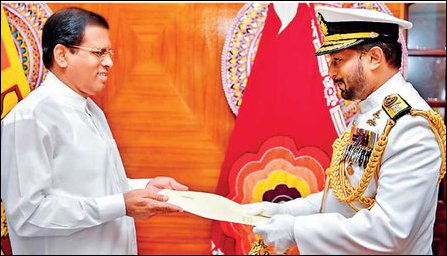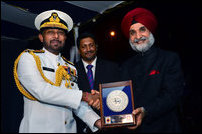
Genocidal Sri Lanka's maritime and naval greed expose attitudes of powers
[TamilNet, Sunday, 18 November 2018, 11:29 GMT]
Maithiripala Sirisena, the incumbent SL President and Ranil Wickramasinghe, the now disputed SL Prime Minister, increased military-to-military maritime training with the USA, India and Japan between 2015 and 2017 while seeking to exploit the China-tilt ‘achievements’ of the Rajapaksa government. The SL Navy was receiving naval vessels as gifts from all the powers after the 2015 regime change. However, the SL State wanted more and more, believing that the geopolitical paradigm experimented through the genocide on Eezham Tamils would bring it fortunes. The naval ambitions went to the extent of wanting 25 powerful naval vessels from different actors to create a powerful naval fleet. At the same time, SL State's maritime economic ambitions were aimed at making Colombo the financial hub in the Indian Ocean.

China is donating a missile frigate class vessel to genocidal Sri Lanka. The frigate is known as Tongling (053H2G FFG 542). It is the last of the four decommissioned Jiangwei I class vessels of China's People's Liberation Army - Navy (PLAN).
By bringing a coalition government, the West hoped to tilt the balance to its favour.
The constitutional changes aspired by the West were not intended to resolve the underlying ethnic conflict. The constitution discourse was designed to lock the island into a world order of the USA created through the IMF, World Bank and various other agencies.
The US ‘engagement’ with Tamils was limited to the scope of conditioning and containing Tamils to a meaningless ‘transitional justice’ paradigm in the island and it was bailing the SL State out from international justice.
While the USA-led grouping was deceiving Tamils, China was not interested at all in coercing Tamils. Knowing the greed of the SL State, Beijing was solely depending on tricking the Sinhala rulers into a debt-trap.
Both, China and the USA have been talking about ‘development’, each from their worldview.
On the ground, the SL State was deploying the so-called ‘development’ to commit structural and heritage genocide on Eezham Tamils.
The ‘development’ partnership seemed to unfold in China's favour.
Mahinda Rajapaksa's regime went to the extent of allowing a Chinese submarine to dock at Colombo in October 2014.
However, Maithiripala regime had to refuse similar access to China in 2017 politely.
China, knowing the result of acid-test, wants Colombo to restore the level of naval access on equal footing to other powers.
Simply put, China wants ‘Sri Lanka’ to behave as Djibouti.
As far as the Eezham Tamils are concerned, the ‘realpolitik’ choices stood between the devil and the deep blue sea due to the external reasons. The Eezham Tamils also failed to evolve an independent and non-electoral movement as the sole political leadership of the Tamil nation in the homeland and the diaspora.
Eezham Tamils should realise at least now that keeping their central polity locked to the electoral politics as well as to the whims of the geopolitical actors would only bring them more miseries.
* * * The Commander-in-Chief of the armed forces of the unitary state of genocidal Sri Lanka is its executive president.
Travis Jeremy Liyanduru Sinniah, born to a Tamil father (a naval doctor) and a Sinhala mother from Kandy, rose to the ranks in the SL Navy playing crucial roles twice during the Eezham War.
The first one was the controversial detention of LTTE commanders (Lt. Colonel Pulendran, Lt. Colonel Kumarappa and several key LTTE fighters) in 1987, an event that triggered the IPKF-LTTE war sooner rather than later.
The second one was a 30-month-long controversial operation in the international waters with foreign intelligence between 2006 and 2009.
The operation was code-named ‘Sagara Balaya’, a secret mission during which several LTTE vessels were destroyed in the high seas off Indonesia and Australia towards the end of the genocidal war.
While not undermining his claims, the ‘success’ of Operation ‘Sagara Balaya’ was not related to Sinniah's bravery, but to the intelligence which had come from the USA.
The operations were carried out from SLNS Sagara, a Vikram-class offshore patrol vessel that the Indian navy had leased out to the SL Navy in 2006. The vessel is now wholly owned by the SL Navy.
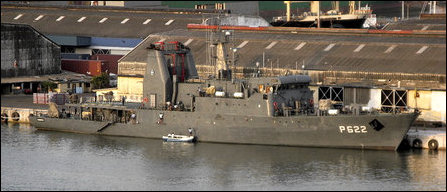
In August 2015, India officially handed over its former Indian Coast Guard Ship Varaha, which had been in service with Sri Lanka Navy as Naval Ship ‘SLNS Sagara’ since 2006.
Sinniah, trained in the USA on counter-terrorism during the Norway-brokered Ceasefire, was recruited as an advisor to US Defence Establishment in 2011 and part of his job was to liaise with the SL Defence Establishment under Gotabhaya Rajapaksa.

Sinniah seen with foreign naval personnel [Photo courtesy: Sri Lanka Mirror]
Six years after Sinniah's US security engagement, SL President Maithiripala Sirisena appointed him as the commander of the SL Navy in August 2017.
A propaganda was let loose suppressing Liyanduru Sinniah's Sinhala-Tamil mixed background. News report were flashed with titles that a Tamil man had become the commander of the SL Navy. (Sinniah himself doesn't want to identify himself as a Tamil. He wants to be seen as a ‘Sri Lankan’)
Admiral Travis Sinniah became the SL Navy commander to have the shortest tenure of just two months in the island's history so far.
The reason for his short tenure was reportedly his refusal to collaborate with the decision of the SL Commander-in-Chief Maithiripala Sirisena's political establishment, which was planning to purchase a Russian-built Gepart 5.1. Offshore Patrol Vessel (OPV) at the cost of $135 million.
The Russian vessel is referred as a frigate capable of engaging enemy aircraft, ships and submarines and was to have artillery and short-range anti-aircraft systems installed in it.

The shipbuilding corporation in Russia specifies Project 11661 "Gepard-3.9" Frigate as “designed to search, track and fight against surface, underwater and air enemy, independently and within task force, carry out convoy missions and patrol duty guard maritime state border and economic zone.” [Photo courtesy: www.aoosk.ru]
The Sinhala critics to the expensive purchase of naval vessels were also questioning why the rush in investing millions in purchasing a Russian frigate while there were competing powers standing in the queue to grant their de-commissioned cutters.
The SL Navy doesn't have a frigate class vessel.
The thinking prevailing in the Sinhala politico-military establishment was that it should upgrade its navy to a frigate class navy to be taken as a serious actor in the maritime affairs of South Asia.
* * * 
SLNS Sayurala

SLCG Suraksha (Previously INS Varuna]

SLCG Suraksha
The largest naval vessel of the SL Navy at the moment (until October 2018) is SLNS Sayurala (P623), which is an advanced offshore patrol vessel (AOPV) built in India at the supervision of the Indian Navy and was commissioned into service in August 2017.
Sayurala is equipped with one "Otto" 76mm main gun and two 30mm sub-guns. The vessel is also provided with a landing and hangar facility for Advanced Light Helicopter. It was tailor-made for the SLN at an estimated $66.55 million cost.
Another AOPV, with the pennant of P624, built in Goa, India, is SLNS Sindurala, commissioned in April 2018. The SL Navy was also planning to install a Multi-barrel Rocket Launch (MBRL) system on SLNS Sindurala.
In September 2017, India donated an Offshore Patrol Vessel, previously named INS Varuna, which the SLN commissioned as SLCGS Suraksha (CG 60).
During the times of war, India had gifted two OPVs, Varaha in April 2006 and Vigraha in August 2008.

SLNS Sindurala
In July 2018, China came with the offer of donating a missile frigate class vessel, known as Tongling (053H2G FFG 542), which is the last of the four decommissioned Jiangwei I class ships of its military. The missile frigate is currently being prepared at Hudong–Zhonghua Shipbuilding in Shanghai.

SLCGS Samaraksha and SLCGS Samudra Raksha

Japanese Defense Minister Itsunori Onodera meeting SL President and SL Prime Minister

Japanese Defense Minister Itsunori Onodera visits Trincomalee
In August 2018, Japan donated two coast guard patrol crafts, which received the names SLCGS Samudra Raksha and SLCGS Samaraksha. They are worth US$11 million in total.
Japanese Defense Minister Itsunori Onodera was visiting Hambantota, and Trincomalee harbours on 21st and 22nd of August 2018. It was the first official visit by a Japanese Defence minister to the island.
On 01 October, Japan's largest warship, Kaga and destroyer Inazuma docked at Colombo. It was during that visit Rear Admiral Tatsuya Fukuda, the commander of Kaga, went on record stating that Japan's naval vessels have stopped in the island 50 times over the past five years.
Japan's involvement in strengthening maritime naval collaboration with genocidal Sri Lanka came as the US State Department was planning to donate $39 million to Colombo's Sinhala navy.
On 04 October, when the largest Japanese naval vessel Kaga left the Colombo port, Chinese navy ship Hai Yangdao called at the port on a 3-day visit.
* * * As the USA has increased its military ties with Inda as a major strategic partner (and soon to an ally) level, they are now talking about ‘Bay of Bengal Initiative’ for military coordination of the small state actors in the region.
During the times of Obama administration and its continuation, there were two “Sri Lanka - US Partnership” dialogues.
The first one was held in February 2016 at Washington D.C., and the second dialogue meeting took place in Colombo in November 2017, which is a continuation of the policy laid down during the times of Obama administration.
“Bilateral security sector cooperation continues in parallel with Sri Lanka’s ongoing reconciliation, rule of law and judicial reform efforts. This also includes U.S. support for demining, joint military engagements, human rights training of Sri Lankan officers, and visits by ships and military officials,” said a joint statement issued on 06 November 2017. That meeting was led by U.S. Under Secretary of State for Political Affairs Thomas Shannon and SL Foreign Secretary Prasad Kariyawasam.
Note the ‘human rights’ language of Thomas A. Shannon, who was appointed as US Secretary of State for Political Affairs by Barack Obama in February 2016.
In June 2016 he had called China's move for domination in the South China Sea a “madness”. Shannon had also played a crucial role in bringing India into the fold of the USA.
Shannon's “Sri Lanka - US Partnership” dialogue in 2017 announced that the United States would offer a second U.S. Coast Guard cutter to the Sri Lankan Navy, pending completion of Congressional notification.
Accordingly, a 378-foot high endurance cutter, USCG Sherman (WHEC 720), which was in service during the Vietnam War, has been transferred to the SL Navy in October 2018. Now, it is the largest vessel in the SL Navy fleet, according to the information published by the U.S. Coast Guard. The vessel has received pennant number P626.

Decommissioned USCG Sherman, USA's gift to genocidal Sri Lanka in 2018
The US Foreign Military Sales Program was also providing $12 million in equipment, technical assistance and (centre section and generator) overhaul work of the vessel, upgrade and training period in Honolulu, before it reaches the island in February 2019.
Before transferring the high-endurance cutter Sherman, the US State Department came with an announcement on 13 August 2018, that it would be providing $39 million in “foreign military financing”, pending congressional approval.

USCG Courageous
Sherman is the second USCG vessel to be gifted by the USA to the navy of genocidal Sri Lanka. The previous gift, USCG Courageous – deployed as SLNS Samudura (P621), was given in June 2004. The US gift, made during the Norwegian brokered ceasefire in the island, was used to intercept and destroy the LTTE vessels in the run-up to the genocidal onslaught in 2009.
"We look forward to discussing with the government of Sri Lanka how this contribution can support our 'Bay of Bengal initiative' and Sri Lanka's humanitarian assistance and disaster response priorities," a press statement issued by the US Embassy in Colombo said.
Again, note the terms ‘foreign military financing’ and the ‘Bay of Bengal Initiative’.
The $39 million was coming from a package of nearly $300 million in additional funding intended for countries in South and Southeast Asia to “ensure a free, open, and rules-based order in the Indo-Pacific region,” the US announcement further stated.
In the meantime, the missile-frigate of China, which is yet to be transferred to the SL Navy, has received pennant number P625.
The USCG Sherman was given the pennant number of P626.
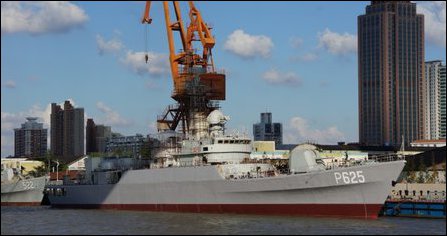
“Tongling” being prepared at Hudong–Zhonghua Shipbuilding in Shanghai
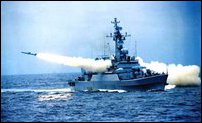
China's Tongling missile-frigate
The news of China donating missile frigate was announced for the first time in July this year by China's Military Attaché, Senior Colonel Xu Jianwei, at the Chinese embassy in Colombo.
The US announcement was made last November.
China's People’s Liberation Army Navy (PLAN) will also be providing “various training” to the SL military and build an auditorium complex at the Sri Lanka Military Academy, Xu was cited as saying by Colombo media in July.
The modernised "Tongling" missile frigate is equipped with a main turret holding dual Type 79 100 mm cannons and two Type 76A dual-37 mm Anti-Aircraft Guns at the aft. It has a helipad and hangar as well.
* * *
SL military taking part in MILEX-18 at Pune, India
The first military exercise of the Bay of Bengal Initiative, code-named MILEX-18, was held in Pune, the second largest city in the western Indian state of Maharashtra, between the 10th and 16th of September, 2018.
Two countries, Nepal and Thailand, refused to take part in it.
Nepal's Foreign Minister Pradeep Kumar Gyawali said BIMSTEC was a forum to promote regional development, "which does not prioritise military exercises".
Nepal has inked an agreement with China, which has allowed to use its ports for sending and receiving shipments, ending Kathmandu's dependence on India for maritime trade.
Besides, Nepal has also been taking part in military exercises with China in July and in September.
Thailand said MILEX-18 was not discussed during the BIMSTEC summit and refrained from sending its troops. Both the countries sent only observers.
The Bay of Bengal Initiative for Multi-Sectoral Technical and Economic Cooperation (BIMSTEC) is a multilateral grouping of seven countries comprising
India, Nepal, Bangladesh, Bhutan, Sri Lanka from South Asia and Myanmar, Thailand from South East Asia.
India was not interested in a military training programme through the SAARC grouping as it wanted to exclude Pakistan. Thus, a military agenda has been pushed through the BIMSTEC, and Donald Trump's US administration is in sync with the approach.

BIMSTEC countries
US Pacific Commander Admiral Harry Harris who addressed SL military's naval conference ‘Galle Dialogue’ in November 2016, claimed he was working to “deepen the military-to-military relationship”. He was the first American four-star officer to visit the island in almost a decade.
The term ‘Indo-Asia-Pacific’ more accurately captures the fact that the “Indian and Pacific Oceans are the economic lifeblood linking the Indian Subcontinent, Southeast Asia, Australia, Northeast Asia, Oceania, and the United States together,” he said.
“I’ve heard it said that there are three things that one must take into consideration when evaluating strategic significance: location, location, and location,” he said.
“But location without stability and security is a hollow place,” the then USPACOM Commander said.
He was calling the “rules-based international order” a “global operating system”.

“Api Eketah Vede Kerahmoo,” proclaimed Commander of U.S. Pacific Command, Admiral Harry Harris in Colombo in 2016. He met with SL President Maithripala Sirisena and affirmed U.S. Commitment to enhance bilateral cooperation with ‘Sri Lanka’. He visited the island in November 27-29 to attend the Galle Dialogue 2016 maritime security conference [Photo courtesy: U.S. Embassy in Colombo]
“Peace and prosperity are made possible through adherence to the principles that are the foundation of the global operating system – freedom of navigation and overflight for all civilian and military vessels, unimpeded lawful commerce, and the peaceful resolution of disputes.”
“So my message today is a simple one: To continue along a prosperous path, we must expand partnerships among like-minded nations to uphold the rules-based global operating system. This helps build what US Defense Secretary Carter calls a principled security network,” Admiral Harry Harris said.
“That’s especially important considering this year’s first port visits to Sri Lanka by US Navy ships since 2011. This validates the strengthening of military ties – a benchmark event in the Sri Lanka-US bilateral relationship,” Harris continued.
“In March, USS Blue Ridge, the US 7th Fleet Flag Ship, hosted President Sirisena right here in Colombo’s port. Its success paved the way for subsequent port visits by three other US ships this year – USS New Orleans, USS Frank Cable, and most recently the USS Somerset which visited Trincomalee just a few days ago.”
“Significantly, USS Somerset and her embarked Marines conducted a theater security cooperation exchange with the Sri Lanka Navy and Marine Corps. This exchange focused on honing basic military skills and small boat operations that could support humanitarian assistance and disaster relief missions.”
“Expanded cooperation with the United States – cooperation that benefits both countries in meaningful ways – will be matched with Sri Lanka’s efforts to continue on its path of reconciliation and transparency after three decades of tragic conflict,” he said.
“And one area of cooperation is in maritime security. Sri Lanka and the United States, as well as India and Australia, rightfully take maritime security in the Indian Ocean seriously as a result of the significant challenges that exist in this region to threaten stability and prosperity – challenges like piracy, terrorism and illegal trafficking in all its bad forms.”
Concluding, “Api Eketah Vede Kerahmoo,” he said in Sinhala, meaning “we will work together.”
Admiral Harry Harris, who was commanding the US Pacific Command, retired from his service in May 2018. He is now working together with South Korea as the US Ambassador to that country.
* * * Admiral Philip S. Davidson heads the US Pacific Command, which is now renamed US Indo Pacific Command.
On April 17, 2018, Admiral Davidson, at a testimony before US Senate Committee on Armed Services, had the following to say, note his citing of Hambantota in the excerpts that follow:
“China is expanding its access to foreign ports to pre-position the necessary logistics support required to regularize and sustain deployments in the Indian Ocean region. This larger overseas logistics and basing footprint will enable Beijing to project and sustain military power at greater distances from China.”

Admiral Philip S Davidson, 25th commander of U.S. Indo-Pacific Command
“The nations that accept China’s offer of low interest loans, grants, and other financial incentives risk Beijing later manipulating economic deals into future security arrangements, and when these countries are unable to pay, Beijing often offers to swap debt for equity (e.g., the Port of Hambantota in Sri Lanka). Ultimately, BRI provides opportunities for China’s military to expand its global reach by gaining access to foreign air and maritime port facilities. This reach will allow China’s military to extend its striking and surveillance operations from the South China Sea to the Gulf of Aden. Moreover, Beijing could leverage BRI projects to pressure nations to deny U.S. forces basing, transit, or operational and logistical support, thereby making it more challenging for the United States to preserve international orders and norms.”
“Due to the distances involved in the Indo-Pacific, we cannot rely solely on surge forces from the Continental United States to deter Chinese aggression or prevent a fait accompli.”
“China has undergone a rapid military modernization over the last three decades and is approaching parity in a number of critical areas; there is no guarantee that the United States would win a future conflict with China. However, I also believe that the United States still maintains significant advantages in the quality of our personnel, the quality of our training, and in our ability to plan and integrate across the joint force. To prevent a situation where China is more likely to win a conflict, we must resource high-end capabilities in a timely fashion, preserve our network of allies and partners, and continue to recruit and train the best Soldiers, Sailors, Airmen, Marines, and Coastguardsmen in the world.”
“The current state of U.S.-India relations presents a historic opportunity to deepen ties and solidify what could develop into the defining partnership of the 21st Century. In less than three decades, India and the United States have moved from “estranged democracies” to a budding strategic partnership. The recent National Security Strategy and National Defense Strategy highlight the prominence of India and encourage India’s development as a net security provider in the South Asian subcontinent and the Indian Ocean region.”
“The continued growth of our partnership should focus on closer collaboration on common security interests, expanding India’s Major Defense Partner status (MDP), and concluding key foundational agreements that will increase interoperability between our forces and facilitate high-end cooperation.”
“Maritime security concerns for Japan and Korea are much different than those of Sri Lanka, Bangladesh, or Vietnam and our approach to satisfy those concerns likewise differ. Japan and Korea may prioritize the sale or co-development of high end defensive capabilities like AEGIS, while Bangladesh, Sri Lanka, and Vietnam may focus on developing national coast guard capabilities through the transfer of Excess Defense Articles. That said, the focus is not, nor should it be on hardware, but rather on sustainability – the training, infrastructure, school houses, etc. – that turns hardware into real capacity and furthers relationships.”
* * * Although the US access to Trincomalee is taking place on par with the attached clauses to the Indo-Lanka Accord of 1987, seen from an Indian perspective, especially after the security access related pacts signed in 2018 between the USA and India, there was also another nuance to US access to Trincomalee in 2017.
In September 2017, Major Nicholas R Nappi of US Marine Corps, who took part in training the SL Navy Marine Corps sheds more light on how US naval exercises in Trincomalee were pitched to speed up the politico-military processes in India.
Some excerpts from his article follow:
“U.S. maritime engagements with India can be best described as a security cooperation courtship that never gets past the first date,” U.S. Marine Corps Major writes in an article to the Proceedings Magazine of the U.S. Naval Institute.
“If India is not ready, willing, or able to play in the maritime security cooperation game, what is the benefit of trying to force it? India will play when it is ready. In the meantime, an open door to the Indian Ocean region (IOR) is staring the Sea Services square in the face: Sri Lanka,” he observes.

SL Marine Corps at Trincomalee photographed by Major Nicholas R. Nappi of U.S. Marine Corps [Photo courtesy: USNI Proceedings Magazine - September 2017 Vol. 143/9/1,375]
“Sri Lanka represents a ‘gap’ in security cooperation, in the most positive sense. It is providing us an ‘open door’ to amphibious force development in the Indian Ocean. The Sri Lanka Navy has just formed a Marine Corps, and it wants our help with doctrine and training. Its Sailors and Marines are professional, battle-hardened, and want to emulate the U.S. Marine Corps. U.S. Sea Services also can learn from the Sri Lankans, especially from their experience in opposed, amphibious landings against the Liberation Tigers of Tamil Eelam (LTTE). Developing this relationship represents a win-win for both the United States and Sri Lanka and provides Marine expeditionary units and amphibious ready groups (MEUs/ARGs) access and training areas in Trincomalee, the ‘finest natural harbor in the Indian Ocean’.”
“The way in which the LTTE was crushed raised human rights concerns with the U.S. Department of State. One entity that chose not to judge Sri Lanka was China. It has invested heavily in this strategic country and has gained an ‘undeniable economic foothold.’”
“Thankfully, China’s foothold is not a political one. Sri Lanka maintains close ties with India, and it desires to strengthen its relationship with the United States, especially in the area of defense professionalization. Sri Lanka represents the most promising option for both immediate and sustained U.S. maritime access to the IOR. It is imperative the United States raise Sri Lanka in importance and priority with respect to security cooperation. If we do not, we run the risk that China will become its defense partner of choice.”
“Forming a new Marine Corps was the Sri Lanka Navy’s way to address both its structure issues and operational demands. The catalyst for the decision came from two 2015 Marine Corps Forces Pacific/Fleet Marine Forces Pacific engagements: the USPACOM Amphibious Leaders Symposium (PALS) and the Key Leader Engagements (KLEs) in Colombo, Sri Lanka. The director of Sri Lanka Naval Land Operations attended PALS-15 in Hawaii. At this inaugural event, he gained an appreciation for amphibious capability and how it could be used by Sri Lanka. Lessons he learned from PALS-15 dovetailed into Key Leader Engagements that occurred between Sri Lanka Navy leadership and Brigadier General Edward Banta at the November 2015 Marine Corps Ball in Colombo. These engagements resulted in the Sri Lanka Chief of Navy’s decision to develop up to two battalions of Sri Lanka Marines.”
“In January 2016, the Sri Lanka Navy made its first overtures to the U.S. Marine Corps for assistance. In the year since then, the Sri Lanka Navy/Marine Corps and the U.S. Sea Services have completed numerous successful engagements in both Sri Lanka and the United States. These engagements were not planned out years in advance, but rather weeks and sometimes days in advance. This budding relationship provided the MEUs/ARGs with previously untapped training areas in the Indian Ocean. These areas, particularly Trincomalee, could prove invaluable in maintaining the training and readiness of the MEUs/ARGs as they make the long transit to the Central Command area of operations.”
“In November 2016, the 11th Marine Expeditionary Unit and the Makin Island (LHD-8) Amphibious Ready Group were transiting the Indian Ocean and had planned port calls in India and Sri Lanka. The India port call was planned more than nine months in advance, and the Sri Lanka port call was planned just one month in advance. One port call never happened, and one was an incredible success.”
“Maritime engagement with Sri Lanka is an open door to the Indian Ocean region. The door for engagement with India is ajar, but it still has the security chain on. In a period of reduced manpower and resources, the U.S. Sea Services cannot afford inefficiency in security cooperation engagements; we increasingly are compelled to show “bang for the buck.” Engagements with Sri Lanka are showing immediate results—the biggest of which is access and training opportunities for transiting MEUs/ARGs.”
“Strategic guidance tells us to foster access to the Indian Ocean region, not just India. Sri Lanka is that access and wants to play with us. When we put all our efforts into India, we usually end up playing by ourselves.”
Related Articles:26.08.18
U.S. naval partnership with genocidal Sri Lanka escalates wi..
External Links:
Chronology:









